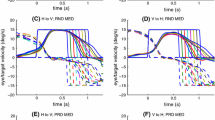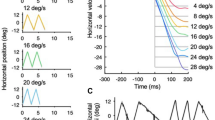Abstract
This study examines the effects of expectation on the timing of ocular pursuit termination. Human subjects pursued repeated, constant velocity (15 or 30°/s) target motion stimuli (ramps), moving left or right. Ramps were of constant duration (RD=240, 480, 720 or 960 ms), resulting in anticipatory slowing of eye velocity prior to ramp termination and target extinction. At unexpected intervals RD was increased or decreased, but velocity remained constant. When RD increased eye velocity continued to decline, even though the target remained visible and continued to move. It took ~180 ms before eye velocity started to recover towards the steady state velocity level for the continued target motion. When RD decreased, eye velocity continued as if for a longer ramp duration, again taking ~180 ms before eye velocity started to decrease. These results suggest that timing of the response to the expected ramp duration had been pre-programmed on the basis of prior experience of ramp duration. Moreover, adjustments to timing occurred rapidly, within the second presentation of the new RD. Responses were compared to control conditions with randomised ramp duration. Eye velocity declined later in the controls for RD≤720 ms, as expected, but exhibited similar decline in predictable and randomised conditions for RD=960 ms. Further controls established that eye velocity could only be reliably maintained until the end of the ramp when the target was expected to continue in motion after the end of the ramp. The results suggest that estimates of stimulus duration are made continuously in all conditions, based on expectancy of target termination.








Similar content being viewed by others
References
Barnes GR, Asselman PT (1991) The mechanism of prediction in human smooth pursuit eye movements. J Physiol (Lond) 439:439–461
Barnes GR, Asselman PT (1992) Pursuit of intermittently illuminated moving targets in the human. J Physiol (Lond) 445:617–637
Barnes GR, Donelan AS (1999) The remembered pursuit task: evidence for segregation of timing and velocity storage in predictive oculomotor control. Exp Brain Res 129:57–67
Barnes GR, Hill T (1984) The influence of display characteristics on active pursuit and passively induced eye movements. Exp Brain Res 56:438–447
Barnes GR, Schmid AM (2002) Sequence learning in human ocular smooth pursuit. Exp Brain Res 144:322–335
Barnes GR, Grealy MA, Collins S (1997) Volitional control of anticipatory ocular smooth pursuit after viewing, but not pursuing, a moving target: evidence for a re-afferent velocity store. Exp Brain Res 116:445–455
Barnes GR, Schmid AM, Jarrett CB (2002) The role of expectancy and volition in smooth pursuit eye movements. Prog Brain Res 140:239–254
Becker W, Fuchs AF (1985) Prediction in the oculomotor system: smooth pursuit during transient disappearance of a visual target. Exp Brain Res 57:562–575
Bennett SJ, Barnes GR (2003) Human ocular pursuit during the transient disappearance of a moving target. J Neurophysiol 90:2504–2520
Boman DK, Hotson JR (1992) Predictive smooth pursuit eye movements near abrupt changes in motion direction. Vis Res 32:675–689
Carl JR, Gellman RS (1987) Human smooth pursuit: stimulus-dependent responses. J Neurophysiol 57:1446–1463
Cheng M, Outerbridge JS (1975) Optokinetic nystagmus during selective retinal stimulation. Exp Brain Res 23:129–139
Churchland AK, Lisberger SG (2002) Gain control in human smooth-pursuit eye movements. J Neurophysiol 87:2936–2945
Churchland MM, Chou I-H, Lisberger SG (2003) Evidence for object permanence in the smooth-pursuit eye movements of monkeys. J Neurophysiol 90:2205–2218
Creelman CD (1962) Human discrimination of auditory duration. J Acoust Soc Am 34:582–593
Dallos PJ, Jones RW (1963) Learning behaviour of the eye fixation control system. IEEE Trans Ac-8:218–227
de Brouwer S, Missal M, Barnes GR, Lefevre P (2002) Quantitative analysis of catch-up saccades during sustained pursuit. J Neurophysiol 87:1772–1780
Dodge R, Travis RC, Fox JC (1930) Optic nystagmus III. Characteristics of the slow phase. Arch Neurol Pscyhiatry Chicago 24:21–34
Dunlap K (1910) Reactions to rhythmic stimuli, with attempt to synchronize. Psychol Rev 17:399–416
Fukushima K, Yamanobe T, Shinmei Y, Fukushima J (2002) Predictive responses of peri-arcuate pursuit neurons to visual target motion. Exp Brain Res 145:104–120
Gellman RS, Carl JR, Miles FA (1990) Short latency ocular-following responses in man. Vis Neurosci 5:107–122
Gibbon J, Church RM, Meck WH (1984) Scalar timing in memory. Ann N Y Acad Sci 423:52–77
Gottlieb JP, Bruce CJ, MacAvoy MG (1993) Smooth eye movements elicited by microstimulation in the primate frontal eye field. J Neurophysiol 69:786–799
Harrington DL, Haaland KY, Hermanowicz N (1998) Temporal processing in the basal ganglia. Neuropsychology 12:3–12
Heinen SJ, Liu M (1997) Single-neuron activity in the dorsomedial frontal cortex during smooth-pursuit eye movements to predictable target motion. Vis Neurosci 14:853–865
Ivry RB, Keele SW (1989) Timing functions of the cerebellum. J Cognit Neurosci 1:136–152
Jarrett CB, Barnes GR (2002) Volitional scaling of anticipatory ocular pursuit velocity using precues. Cog Brain Res 14:383–388
Jarrett CB, Barnes GR (2003) The volitional inhibition of anticipatory ocular pursuit using a stop signal. Cog Brain Res 17:759–769
Jueptner M, Rijntjes M, Weiller C, Faiss JH, Timmann D, Mueller SP, Diener HC (1995) Localization of a cerebellar timing process using PET. Neurology 45:1540–1545
Kao GW, Morrow MJ (1994) The relationship of anticipatory smooth eye movement to smooth pursuit initiation. Vis Res 34:3027–3036
Kowler E (1989) Cognitive expectations, not habits, control anticipatory smooth oculomotor pursuit. Vis Res 29:1049–1057
Kowler E, Steinman RM (1979a) The effect of expectations on slow oculomotor control-I. Periodic target steps. Vis Res 19:619–632
Kowler E, Steinman RM (1979b) The effect of expectations on slow oculomotor control-II. Single target displacements. Vis Res 19:633–646
Krauzlis RJ, Miles FA (1996) Transitions between pursuit eye movements and fixation in the monkey: dependence on context. J Neurophysiol 76:1622–1638
Lisberger SG, Pavelko TA (1989) Topographic and directional organization of visual motion inputs for the initiation of horizontal and vertical smooth-pursuit eye movements in monkeys. J Neurophysiol 61:173–185
Maquet P, Lejeune H, Pouthas V, Bonnet M, Casini L, Macar F, Timsit BM, Vidal F, Ferrara A, Degueldre C, Quaglia L, Delfiore G, Luxen A, Woods R, Mazziotta JC, Comar D (1996) Brain activation induced by estimation of duration: a PET study. Neuroimage 3:119–126
Maricq AV, Roberts S, Church RM (1981) Methamphetamine and time estimation. J Exp Psychol Anim Behav 7:18–30
Meck WH (1986) Affinity for the dopamine D2 receptor predicts neuroleptic potency in decreasing the speed of an internal clock. Pharmacol Biochem Behav 25:1185–1189
Miall RC (1992) Oscillators, predictions and time. In: Macar F, Pouthas V, Friedman WJ (eds) Time, action and cognition. Kluwer Academic Publisher, Dordrecht, pp 215–227
Missal M, Heinen SJ (2001) Facilitation of smooth pursuit initiation by electrical stimulation in the region of the supplementary eye fields. J Neurophysiol 86:2413–2425
O’Boyle DJ, Freeman JS, Cody FWJ (1996) The accuracy and precision of timing of self-paced, repetitive movements in subjects with Parkinson’s disease. Brain 119:51–70
Pola J, Wyatt HJ (1985) Active and passive smooth eye movements: Effects of stimulus size and location. Vis Res 25:1063–1076
Pola J, Wyatt HJ (1997) Offset dynamics of human smooth pursuit eye movements: effects of target presence and subject attention. Vis Res 39:2767–2775
Rammsayer TH (1994) A cognitive-neuroscience approach for elucidation of mechanisms underlying temporal information processing. Intern J Neuroscience 77:61–76
Rao SM, Mayer AR, Harrington DL (2001) The evolution of brain activation during temporal processing. Nature Neuroscience 4:317–323
Rashbass C (1961) The relationship between saccadic and smooth tracking eye movements. J Physiol (Lond) 159:326–338
Robinson DA, Gordon JL, Gordon SE (1986) A model of the smooth pursuit eye movement system. Biol Cybern 55:43–57
Rosenbaum DA (1991) Human motor control. Academic Press, San Diego
Schwartz JD, Lisberger SG (1994) Modulation of the level of smooth pursuit activation by initial tracking conditions in monkeys. Vis Neurosci 11:411–424
Staddon JER, Higa JJ (1999) Time and memory: towards a pacemaker-free theory of interval timing. J Exp Analysis Behav 71:215–251
Stevens LT (1886) On the time-sense. Mind 11:393–404
Tanaka M, Lisberger SG (2001) Regulation of the gain of visually-guided smooth pursuit eye movements by frontal cortex. Nature 409:191–194
Tian J, Lynch JC (1995) Slow and saccadic eye movements evoked by microstimulation in the supplementary eye field of the cebus monkey. J Neurophysiol 74:2204–2210
Treisman M (1963) Temporal discrimination and the indifference interval: implications for a model of the “internal clock”. Psychological Monographs: General and Applied 77:1–31
Tychsen L, Lisberger SG (1986) Visual motion processing for the initiation of smooth-pursuit eye movements in humans. J Neurophysiol 56:953–968
Wells SG, Barnes GR (1999) Predictive smooth pursuit eye movements during identification of moving acuity targets. Vis Res 39:2767–2775
Westheimer G, McKee SP (1975) Visual acuity in the presence of retinal-image motion. J Opt Soc Am 65:847–850
Wing AM, Kristofferson AB (1973a) Response delays and the timing of discrete motor responses. Percept Psychophys 14:5–12
Wing AM, Kristofferson AB (1973b) The timing of interresponse intervals. Percept Psychophys 13:455–460
Author information
Authors and Affiliations
Corresponding author
Rights and permissions
About this article
Cite this article
Barnes, G.R., Collins, C.J.S. & Arnold, L.R. Predicting the duration of ocular pursuit in humans. Exp Brain Res 160, 10–21 (2005). https://doi.org/10.1007/s00221-004-1981-3
Received:
Accepted:
Published:
Issue Date:
DOI: https://doi.org/10.1007/s00221-004-1981-3




